#subantarctic
Explore tagged Tumblr posts
Text
Re-greetings
Re-greetings between Antipodean albatrosses, who have spent a year at sea.
Albatrosses are famously ‘monogamous’, choosing one partner to nest with for most, if not all, of their life. Real life is messy, and this does come with caveats – there’s a bit of ‘extra-pair copulation’ that goes on, and if breeding doesn’t work out well they may choose another partner, if they can. With the large sex-bias towards males in the Antipodean Albatross population, a lot of the males…
3 notes
·
View notes
Photo

A new variant has been added!
Subantarctic Snipe (Coenocorypha aucklandica) © georgiasteel
It hatches from aerial, black, brown, daytime, dense, long, nocturnal, possible, slight, small, and vagrant eggs.
squawkoverflow - the ultimate bird collecting game 🥚 hatch ❤️ collect 🤝 connect
2 notes
·
View notes
Text

Subantarctic Skua (Stercorarius antarcticus). South Atlantic.
7 notes
·
View notes
Text
going to shit my pants on purpose cos why is new zealand SO HOSTILE towards young people trying to eat food and live in a house….!!!!!!!!!! im in the uk and everyone’s complaining about cozzie livs while Im like AAAAAAAARRGGHHHHH!!!!!!!!! YOU DON’T KNOW HOW GOOD YOU HAVE IT!!!!!!!!!!!!!!!!!!!!!
#oh your heating is expensive??#YOU MEAN YOUR HOUSES ACTUALLY HAVE HEATING???????????????????#killing maiming biting etc#then they are surprised when i say half of nz is a subantarctic island w penguins and southern lights and snow#and we live in fucking stupid mouldy wooden houses with no amenities for $240pw#veges here are like 40p im actually sobbing#losing it#food is so fucking cheap#average shitty houses don’t cost 1.2 million#i could go on#personal#RANT
17 notes
·
View notes
Text
saw a penguin today 👍👍
#it was dead but still cool#you dont often get subantarctic species washed up#having said that we did see a live rockhopper a coupple of years back which was epic-er
1 note
·
View note
Text
vimeo
Learn a little about MEGAHERBS ! This is a trip we did in 2011 to the subantarctic islands just south of New Zealand. We were supporting research done by an amazing group of scientists from the University of Otago. Awesome people, great projects and stunning scenery. Interview of Lorna Little, Department of Botany, University of Otago, New Zealand.
0 notes
Text
vote me for communist prime minister and I'll add 100 new emojis entirely of subantarctic seabirds.
2K notes
·
View notes
Text
SO
Reischek's parakeet!
we think there is about 4,000-6,000 of them spread out throughout the subantarctic islands (including all the little satellite islands) where you’ll mainly find them on the plains, coastal fringes or occupying currently empty penguin colonies
we don’t know too much about their ecology, but we do know they make burrows in big tussock plants (mainly during the breeding season), that they bask and preen together in sheltered areas, and they’re strong fliers (strong enough to fly between island)
the majority of their diet is plant matter, but they’re also known to eat invertebrates, and occasionally scavenge dead petrels and albatrosses
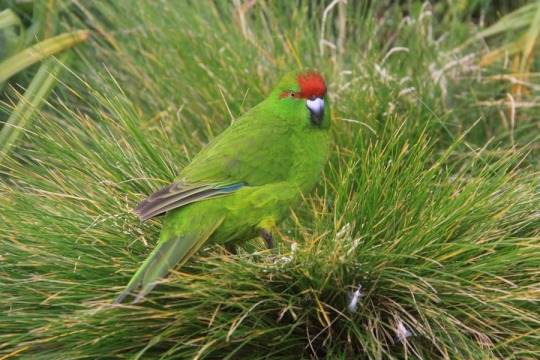


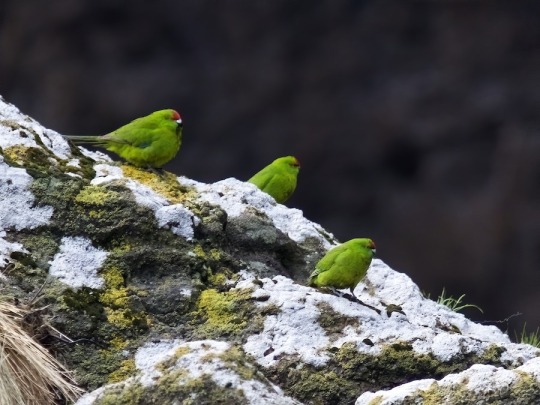
Antipodes parakeet!
these guys are really notable for their diet and food ecology. they mainly eat leaves, however they are well-known for scavenging bird carcasses and broken eggs, and more surprisingly - they go into burrows and kill and eat grey-backed storm petrels (this makes them the second occasionally predatory parrot in aotearoa alongside the kea)
you’ll find these guys also in the subantarctic antipodes islands, in sedges and tussocks, and mainly along slopes and streams. we currently believe there is anywhere between 1,000-2,000 of them across islands
these guys also tunnel and utilise seabird labyrinths throughout tussocks and grasses. so they’re also really well-known for disappearing and popping up a surprising distance away when startled. they are capable of strong flight but they don’t seem to like to use it, so they tend to only fly very short bursts, and are seen hopping around a lot
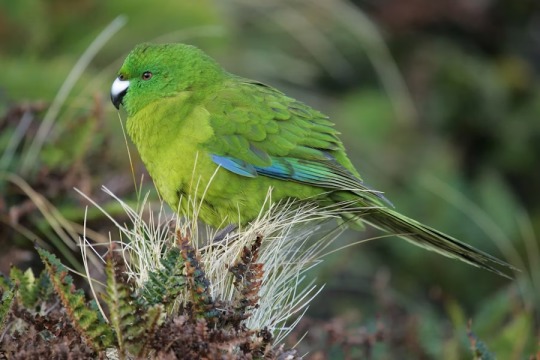
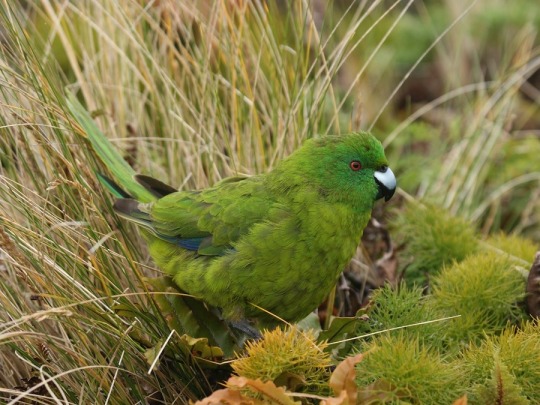
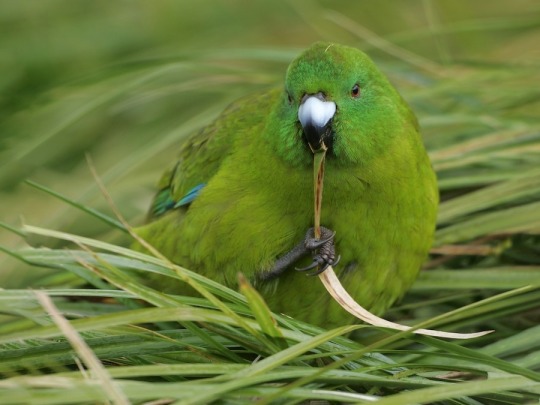
other lesser known parrot species i would love to see hyped up: Reischek's parakeet and Antipodes parakeet!! they’re hanging out down on the subantarctic islands and they are very cool
70 notes
·
View notes
Text

Île des Pingouins, or Penguin Island, is an uninhabited island in the subantarctic Crozet Archipelago of the southern Indian Ocean. It is small — just 1 square mile (3 sq. km) — with coastal cliffs ranging from 164 to 984 feet (50-300 meters) tall, making it virtually inaccessible by sea. The island is an important nesting site for seabirds and has an exceptionally high density of avian residents, including a million pairs of macaroni penguins.
-46.416667°, 50.400000°
Source imagery: Airbus Space
356 notes
·
View notes
Note
Can we get a list of seal species that haven't been posted so we can make bingo sheets? :)
I saw this ask and briefly got really excited and almost started making my own then reread. Anyways!
Crabeater seal
Galapagos sea lion
South American sea lion
Brown fur seal
Subantarctic fur seal
Guadalupe fur seal
Juan Fernandez fur seal
Galapagos fur seal
Antipodean fur seal (Kekeno)
South American fur seal
151 notes
·
View notes
Text
Everyday scenes on Antipodes island.
2 notes
·
View notes
Text
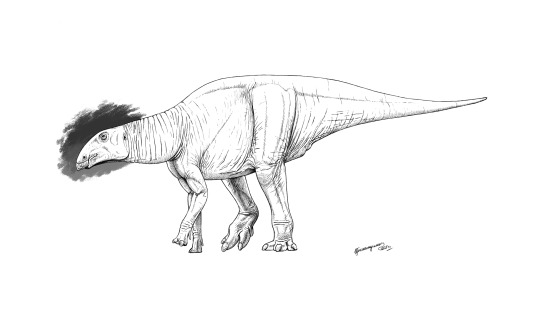
Sketch of the relic hadrosauroid Gonkoken nanoi from Maastrichtian of Chile. It is known from the numerous bones of several individuals. Gonkoken possesses a mixture of primitive and progressive traits and belongs to non-hadrosaurid hadrosauroids. It is assumed that it originated from North American forms that existed before they were replaced by hadrosaurids. The remains of Antarctic and subantarctic "hadrosaurids" may actually belong to Gonkoken-type animals. Apparently, such ornithopods flourished in the far south at the end of the age of dinosaurs. Gonkoken reached 4 meters in length and coexisted with such unusual dinosaurs as the parankylosaur Stegouros elengassen.
Adobe Photoshop, 2025.
#gonkoken nanoi#gonkoken#hadrosauroid#iguanodontia#ornithopoda#maastrichthian#latecretaceous#dinosaur#paleoart#sketch#photoshop
36 notes
·
View notes
Text

The gentoo penguin (Pygoscelis papua) is a medium-sized penguin species found throughout several Antarctic and subantarctic islands and the Antarctic Peninsula. The origin of their common name is unclear; the word "gentoo" was historically used by Europeans and Anglo-Indians to refer to indigenous peoples of India (now considered derogatory) and was possibly applied to the penguins with the insinuation that the white markings on their head are turban-like. Their name is now also known for being shared with a Linux distribution.
#id in alt#penguins#gentoo penguin#my big penguin post that blew up got several ''i didn't know that was a penguin and not just a linux distro'' comments#stretching the suitability for this series but 1. i wanted something easy to draw 2. it's my series i do what i want#''those are real'' series#illustration#digital art#birds#wildlife art
136 notes
·
View notes
Photo


Chilean paleontologists have released their findings on a new duck-billed dinosaur named Gonkoken nanoi, which inhabited Chilean Patagonia in the late Cretaceous, in the late age of the Dinosaur, approximately 70 mya.
The name Gonkoken nanoi means similar to koken or swan in Tehuelche language, the indigenous people that inhabited the region where this species was found, and nanoi in honort to Mario “Nano” Ulloa, who helped during expeditions. It is estimated that it could have measured between 3.5 and 4 meters in length and weighed between 600 kilograms and one ton.
Chilean Patagonia could have been a refuge for these primitive forms of hadrosaurs, which would have migrated to the Southern Hemisphere long before more advanced forms, and it is believed these hadrosaur may have even reached Antarctica, when it was connected to South America.
3D Reconstruction by Christopher Chávez
Reference (Open Access): Alarcón-Muñoz et a., 2023. Relict duck-billed dinosaurs survived into the last age of the dinosaurs in subantarctic Chile. Science Advance
#new species#dinosaur#hadrosaur#Gonkoken nanoi#sciblr#science blr#science#biology#archaeology#fossil#gonkoken
536 notes
·
View notes
Text




Penguins at Vernadsky station in Antarctica!
Almost 4,000 penguins, mostly subantarctic ones, are registered near Vernadsky base. About 900 nests are already with eggs, mostly two. Since the first eggs began to appear in early November, chicks will hatch by mid-December because the maturation period is about 34-36 days. —National Antarctic Scientific Center
#Ukraine#penguins#antarctica#National Antarctic Scientific Center#vernadsky station#vernadsky#animals#Ukrainian scientists
20 notes
·
View notes
Text

71 million years ago as the sun sets before the subantarctic forests of what is now the Dorotea Formation of Chile, a pair of Gonkoken nanoi search the woods for flowers and leaves to eat from bushes while a Stegouros elengassen munches on a couple of ferns in the background.
#dinosaur#paleoart#dinosaurs#paleontography#paleontology#gonkoken#stegouros#Chile#maastrichtian#cretaceous#late cretaceous
396 notes
·
View notes